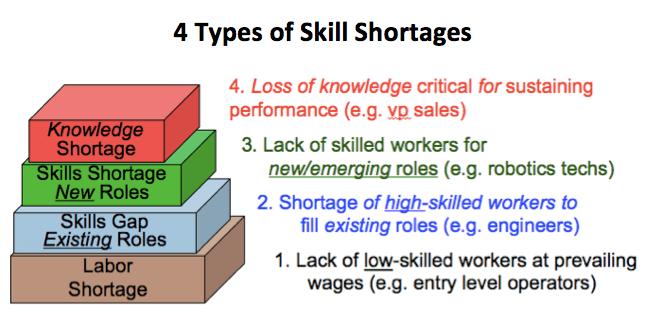- Leaders in a major national travel agency are losing manyexperienced travel agents to retirement, which will hurt the firm’s ability to grow.
- Supply chain industry executives scramble to develop programs to meet the huge demand for supply chain technicians able to repair the automated systems and robots that are becoming core technologies in the distribution process.
- In many hospitals, chief nursing officers struggle to recruit the experienced nurses they need to meet the demands of expanding hospital service lines.
- Forging industry managers strive to find enough entry-level operators who can simply pass pre-employment drug screenings.
These are four examples of costly – but very different – types of “skill shortages” experienced by hiring managers today. Each scenario represents a distinct challenge and requires significantly different solutions. Do you know which type of skills gap you should be most concerned about? And are you using the best approaches to solve it?
Here are four distinct types of skill shortages that undermine organizational performance. Which worries you most? When you listen to other’s ideas for solutions, make sure they’re addressing the same type of problem.
1. Knowledge at Risk Due to Retirements or Unwanted Turnover
In many industries where experience affects performance, the ongoing retirement of baby boomers (now aged 53-71) has created serious skill shortages . Veteran travel agents, lathe operators, civil engineers, government procurement officers, and veteran sales executives. The list is very long. But the loss of critical know how is not always due to retirements. It also occurs with the departure of midcareer employees whose unique capabilities and valuable experience make them essential to the business.
After first specifying which specific knowledge or capability is at risk, one of the biggest payoffs comes from improving the mentoring skills of older experts. Teaching people tactics and tricks for teaching others and transferring knowledge is one of best ways to limit the damage of lost knowledge. See this post on “3 Mentoring Tactics That Matter Most” for more ideas on how to enhance mentoring skills of your veteran employees.
2. Shortage of Qualified Candidates to Fill New/Emerging Roles
Cyber security analysts, supply chain technicians, robotics consultants, big data analytics talent. The list of new jobs driven by rapidly evolving technologies is growing. But these shortages are not widely publicized because the public doesn’t understand these jobs yet.
 Unlike the positions retirees are leaving, these new roles haven’t existed until recently, so there is no ready pool of qualified talent to draw from. In fact, the skills needed are still being defined and available training programs are limited. Companies that depend on filling these roles are going to either have to develop this talent themselves, or find ways to partner effectively with schools to design curriculums that will produce graduates qualified for these new positions.
Unlike the positions retirees are leaving, these new roles haven’t existed until recently, so there is no ready pool of qualified talent to draw from. In fact, the skills needed are still being defined and available training programs are limited. Companies that depend on filling these roles are going to either have to develop this talent themselves, or find ways to partner effectively with schools to design curriculums that will produce graduates qualified for these new positions.
I recently completed a study of successful industry/academic partnerships in the supply chain sector. Executives in other industries can learn what steps are essential for making these relationships successful. You can visit MHI’s website to download the report here.
3. Shortage of Experienced Candidates to Fill Skilled Roles
Technical sales reps, maintenance technicians, skilled trades people, accountants, IT systems engineers, and nurses – the list is endless. This is where the skills gap is being felt most widely. The inability to find trained candidates who also have some work experience is hurting the performance of many organizations today, although those impacts are often hard to quantify. Many companies could grow faster today, if they could just find the talent to fill key roles.
More creative recruiting and retention is an important part of the solution for this type of skill shortage. Specifically, I am seeing more businesses get creative about designing more flexible jobs and in considering more virtual hires.
For example, a California-based bank recently advertised a job for an experienced credit analyst as 60-100% time, just to see what kind of candidates it could attract. A New Mexico hospital has hired young doctors who work 12-hour shifts for seven days in the hospital’s walk-in clinic, and then they are off for seven days.
The CEO of a manufacturing firm says he no longer cares where his 3-D modelers live. These highly skilled engineers, who design customized solutions for the company’s customers, are hard to develop and retain. By creating virtual or remote positions, the executive makes the job more appealing to qualified candidates.
4. Too Few Qualified Entry-level Candidates to Fill Unskilled or Low Skill Jobs.
The forging industry can’t find young operators who can pass a drug test and who are willing to be trained to work on the plant floor. Retailers and fast food outlets can’t hire enough front line workers. Nursing homes struggle to find health-care aides, and it’s difficult to recruit customer service reps. The shortage of low-skilled workers is widely felt but discussed less frequently in the media than other shortages.
Recruiting and retention solutions for attracting lower-skilled employees are likely to be different than intended to attract more highly skilled workers. Click here for some examples of solutions from a company I worked with.
The “skills gap” has become a widely recognized phenomenon. But, like any problem, it must be accurately defined to be solved effectively. Four very different scenarios, as described above, actually characterize critical skill shortages. Make sure you and your colleagues clearly understand which situations you’re facing so you can pursue the most effective solutions.
Contact me if you want to discuss ways I can help your organization produce faster results in addressing your most pressing skill gaps.
